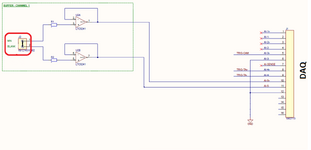mtnkh
Newbie level 6
Hi everyone,
I have come across an issue in a circuit that I would like to discuss. The circuit, shown below, exhibits an offset in the output. The output is given by (AI-5+) - (AI-5-). To investigate further, I short-circuited the input on the left side and observed that the output in this case is equal to 84mV. The resistors R1 and R2 are both set to 100Kohm.
Furthermore, I simulated the circuit using Ltspice, and the output consistently measured almost 84mV. I experimented with different values for R1 and R2, but the output voltage remained unchanged. Therefore, it seems that the offset is not due to the bias current of the OpAmps.
However, I am unable to determine the source or cause of this DC voltage. I would greatly appreciate it if someone could provide an explanation for this phenomenon.
Thank you in advance.

I have come across an issue in a circuit that I would like to discuss. The circuit, shown below, exhibits an offset in the output. The output is given by (AI-5+) - (AI-5-). To investigate further, I short-circuited the input on the left side and observed that the output in this case is equal to 84mV. The resistors R1 and R2 are both set to 100Kohm.
Furthermore, I simulated the circuit using Ltspice, and the output consistently measured almost 84mV. I experimented with different values for R1 and R2, but the output voltage remained unchanged. Therefore, it seems that the offset is not due to the bias current of the OpAmps.
However, I am unable to determine the source or cause of this DC voltage. I would greatly appreciate it if someone could provide an explanation for this phenomenon.
Thank you in advance.
